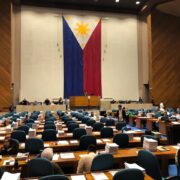Get a taste of Filipino history at this pop-up

When a recipe isn’t written down, food traditions live on through memory, taste, and the very hands that cooked the meal. This is what Offbeat Bistro is doing in their pop-up at the ArteFino lounge—now elevated with foraging, research, and a lot of experimentation.
Last July 29, the ArteFino lounge, surrounded by crafts and artisanal pieces, became the venue for a food lecture titled, “Discovering and Documenting Philippine Culinary Traditions.” This was organized by the Lopez Museum and Library in partnership with ArteFino.
In the intimate lecture, guests were invited to dig in, not just into the food, but to chew on history: savoring with a little looking back.
Looking back
The afternoon began with a talk by Isa Nazareno of the Lopez Museum. She offered a varied look at food in the Philippines, and proposed how it can serve as both archive and artifact. “Where do we find food history?” Nazareno asks. “Most accessible to us are home kitchens, but beyond that, we find it in cookbooks, advertisements, restaurant menus, [and] even old food labels.” While many are ephemeral, Nazareno describes these as “primary materials for those who want to look at food and our relationship with it.”
One particular slide featured a 1930s New Year’s Eve dinner spread at the Oriente Hotel. Another showed Café Valenzuela in Tarlac, which called themselves “the pride of the highway” in their tourism and travel promotion. Another pre-war menu featured a banquet organized to honor a man named Basilio Santiago, the treasurer of Bulacan. The items read delightfully with playful takes on food like, “Hipong sugpo na malilikot sa lalamigan.”
Nazareno encouraged attendees to browse the Lopez Library’s vast culinary archive. She showed written works, including recipes by Maria Orosa—known in history for her food innovations during wartime scarcity. Another showed the writings of the grand dame of Filipino food history, Doreen Fernandez.

Inspired by his travels
Next, chef Nino Angelo Comsti took the stage. The author and restaurateur, known for his meticulous research into regional Filipino cuisine, dove into the variations and nuances of Filipino food tradition. All the while, he spoke with an urgency to preserve recipes.
“It was when I chanced upon the works of Doreen Fernandez and traveled that made me realize I don’t actually know much about Philippine cuisine,” Comsti humbly admits. “And I felt guilty as a writer. Apparently I was just touching the surface…Imagine I learned about Japanese mochi before discovering masi in Cebu, the glutinous rice ball stuffed with sugar.”
And so, Comsti did his due diligence. He traveled to 22 provinces, from Batanes to Tawi-Tawi, for over four years. That’s how his fifth book came to be, with 75 regional dishes. He describes his research process on the field, saying, “I knocked on people’s doors, asked the ates in the carenderia, struck up conversations with taxi drivers, and mustered up the courage to ask strangers to teach [me] their local dishes.”
He shares the wealth of dishes he found: kinalas from Camarines Sur, a savory broth where the meat must fall off the bone. In Pampanga, he was taught balobalo, a fermented rice and shrimp dish (and a personal favorite). We learned about Pancit Puso from Cavite and Calandracas, made of ingredients bought to a wake as abuloy by the grieving guests. We saw the differences of pinangat, which is a vegetable dish in Albay. But in Isabela, pinagnat is a fish cooked in broth. From Samar, we were introduced to types of suman desserts: sagmani, kurukud, and puto conserva.
To end the lecture, Comsti stated, “The more I eat, the less I know. It’s a good thing I’m always hungry.” And with all the talking about food, we were hungry indeed.

Filipino history on a plate
For the tasting portion, Comsti worked with his Offbeat Bistro partner, chef Don Baldosano. Guests were served two small plates that brimmed with complex flavors.
Baldosano took over the microphone to explain his first dish: a refined take on laswa, a childhood favorite he grew up with. “It was actually a staple for us every day. Whatever vegetables we would have, we would turn into a broth and season with ginger,” he explains.
The steaming dish was served with squash, a touch of daing, and the traditional laswa broth. “The idea is you’re having what I had as a kid, but in a more sophisticated fashion,” he says. And with all the flavors swirling in the steaming, hearty dish, it was sophisticated indeed.
Second was a dessert of biko, but elevated. The Filipino rice delicacy was reimagined with risotto. A bit of pandan oil was mixed in with coconut-based latik. And while the flavors worked well together, the most exciting ingredient was cogon. The cogon grass, usually used as a roofing material in Bahay Kubos, came from Batangas. After foraging, the cogon was dried and infused in the milk.
“Essentially, what I’m trying to give you is a taste of what Filipino food can be and with ingredients that people don’t actually know too much about,” the chef states. “We want to show you that Filipino food can be really good.”
If this pop-up and lecture has proven anything, it’s that Filipino cuisine is not static, but a living, breathing, evolving record of who we are as a country. And to top it off, all that heritage tastes delicious.
Offbeat Bistro runs from July 26 to August 3, 2025 at the inaugural ArteFino Lounge, Balmori Chef’s Table in Powerplant Mall, Makati City. For reservations, contact +639562660120.

















